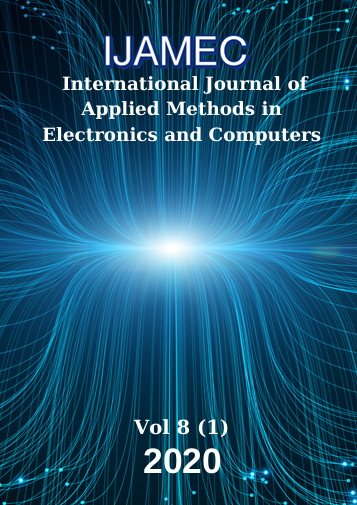The Role of Dysphonia and Voice Recordings in Diagnosis of Parkinson’s Disease
DOI:
https://doi.org/10.18100/ijamec.679038Keywords:
Ensemble gentle boost, Logistic regression, Parkinson's disease, Pitch, Jitter, ShimmerAbstract
Parkinsonism is a syndrome that occurs as a combination of six cardinal signs; resting tremor, rigidity, bradykinesia, loss of postural reflex, flexion posture and freezing (motor block). Parkinson disease occurs with the loss of brain cells which are generating dopamine. The most important primary motor symptoms of Parkinson’s disease are shaking of hands, slowness of movement, and speech changes. Sound changes are not recognized at the early stages of the disease while it becomes evident at the progressive stages. However, speech changes can be detected with some acoustic parameters. This study aims to detect Parkinson’s disease by using voice recordings. In this study, 342 voice recordings that belong to 174 healthy subjects and 168 Parkinson’s disease patients are used. 21 features are extracted from each voice record. The classification of subjects as healthy or with Parkinson disease is achieved by using logistic regression, k-nearest neighboring and ensemble gentle boost techniques. Furthermore, ten-fold and leave-one-out cross validation techniques are applied to improve the performance and reliability of the classifier. Sensitivity, specificity, maximum and average accuracy values are calculated to evaluate the success of the system. The obtained results show that the proposed system can be utilized by the neurologists to diagnose Parkinson’s disease at its early stages.Downloads
References
J. Parkinson, “An essay on the shaking palsy” London, Sherwood, Neely and Jones, 1817.
D. J. Gelb, E. Oliver, S. Gilman, “Diagnostic criteria for Parkinson’s disease”, Arc. Neurology,vol. 56, pp. 33-39, 1999.
Rijk M.C. et al., “Prevelence of Prakinson’s disease in Europe: A colloborative study of population-based cohorts”, Neırology, vol. 54, pp. 21-23, 2000.
H. Ehringer, O. Hornykiewichz, “Distribution of noradrenalin and dopamine in the human brain and their behaviour in disease of extrapyramidal system”, Klin Wochenschr, vol. 38, pp. 1236-1239, 1960.
H. Braak et al., “Staging od brain pathology related to sporadik Parkinson’s disease”, Neurobiology Aging, vol. 24, pp. 197-211, 2003.
H. Braak et al., “Stages in the development of Prakinson’s disease-relates pathology”, Cell Tissue Res., vol. 318, pp. 121-134, 2004.
H. Przuntek, “Early diagnosis in Parkinson’s disease”, J. Neural Trans. Supp., vol. 38, pp. 105-114, 1992.
C. J. Hunker, J. H. Abbs, S. M. Barlow, “The relationship between parkinsonian rigidity and hypokinesia in the orofasial system: A quantative analysis”, Neurology, vol. 32, pp. 749-754, 1982.
S.B.O. Sullivan, T.J. Schmitz, G. Fulk, “Physical Rehabilitation” 5th ed., FA Davis Company, USA, 2013.
S. Fahn, J. Jankovic, M. Hallet, M. Jenner M, P. Anner, “Principles and practice of movement disorders”, Churrhill Livingstone, Chapter 2, Part 4, pp. 81, 2007.
G. M. Schulz, T. Peterson, C. M. Sapienza, “Voice and speech characteristics of persons with Parkinson’s disease pre and post- pallidotomy surgery: Preliminary findings”. J Speech Lang. Hear Res., vol. 42, pp. 1176-1194, 1999.
B. Erdogdu Sakar, M. Isenkul, C.O. Sakar, A. Sertbas, F. Gurgen, S. Delil, H. Apaydin, and O. Kursun, “Collection and Analysis of a Parkinson Speech Dataset with Multiple Types of Sound Recordings”, IEEE Journal of Biomedical and Health Informatics, vol. 17(4),2013, pp. 828-834.
M.A. Little, P.E. McSharry, S.J. Roberts, D.A.E. Costello, and, I.M. Moroz, “Exploiting Nonlinear Recurrence and Fractal Scaling Properties for Voice Disorder Detection”, Biomedical Engineering Online, vol. 6 (23), 2007, pp. 1-19.
Y. Campos-Roca, D. Montã, and C. Pérez, “Parkinson's Disease Detection Based on a Heterogeneous Acoustic Database”, EECSS, Barcelona, Spain, July 13-14, 2015.
D. Braga et al., “Automatic detection of Parkinson’s disease based on acoustic analysis of speech” Eng. Applications of AI, vol. 77, pp. 148-158, 2019.
C. O. Sakar et al., “A comparative analysis of speech signal processing algorithms for Parkinson’s disease classification and the use of the tunable Q-factor wavelet transform”, Applied Soft Computing Journal, vol. 74, pp. 255-263, 2019.
S. Lahmiri, A. Shmuel, “Detection of Parkinson’s disease based on voice patterns ranking and optimized support vector machine”, Biomedical Signal Processing and Control, vol.49, pp. 427-433, 2019.
P. Vizza et. al., “Methodologies of speech analysis for neurodegenerative diseases evaluation”, International Journal of Medical Informatics, vol. 122, pp. 45-54, 2019.
J. Teixeira, “Algorithm for jitter and shimmer measurement in pathologic voices”, Procedia Computer Science. vol.100, pp. 271-279, 2016.
P. Boersma and D. Weenink, “Praat: doing phonetics by computer”, Phonetic Sciences, University of Amsterdam. http://www.fon.hum.uva.nl/praat/.
J. Teixeira and P. Fernandes, “Jitter, shimmer and HNR classification within gender, tones and vowels in healthy voices”, Procedia Technology. vol. 16, pp. 1228-1237, 2014.
J. Han, “Data mining: Concepts and techniques”, 3rd ed., Waltham, Mass.: Morgan Kaufmann Publishers, 2012.
L. Berus, S. Klancnik, M. Brezocnic, M. Ficko, “Classifying Parkinson’s disease based on acoustic measures using artificial neural networks”, Sensors. vol. 19, pp. 1-15, 2019.
Downloads
Published
Issue
Section
License
Copyright (c) 2020 International Journal of Applied Methods in Electronics and Computers

This work is licensed under a Creative Commons Attribution-ShareAlike 4.0 International License.





